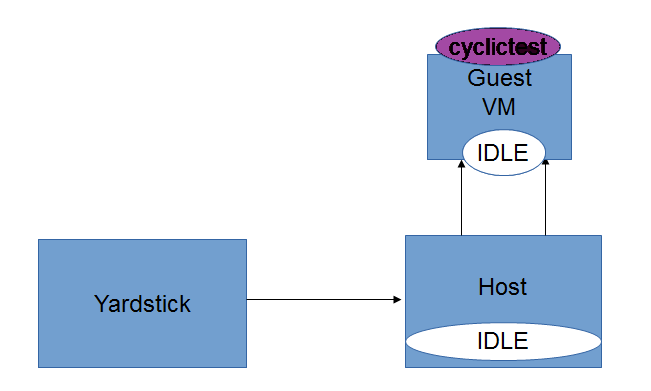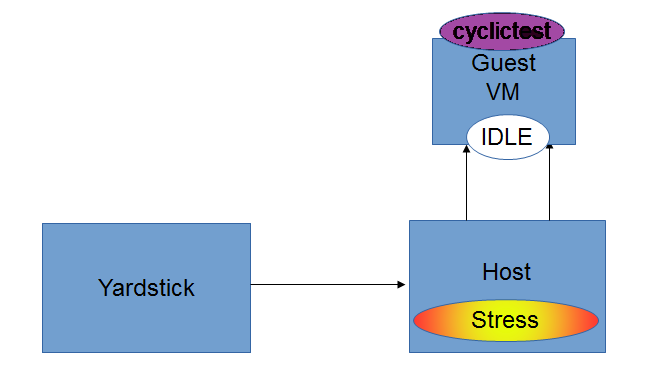4. Low Latency Feature Configuration Description¶
4.1. Introduction¶
In KVM4NFV project, we focus on the KVM hypervisor to enhance it for NFV, by looking at the following areas initially
- Minimal Interrupt latency variation for data plane VNFs:
- Minimal Timing Variation for Timing correctness of real-time VNFs
- Minimal packet latency variation for data-plane VNFs
- Inter-VM communication,
- Fast live migration
4.2. Configuration of Cyclictest¶
Cyclictest measures Latency of response to a stimulus. Achieving low latency with the KVM4NFV project requires setting up a special test environment. This environment includes the BIOS settings, kernel configuration, kernel parameters and the run-time environment.
- For more information regarding the test environment, please visit https://wiki.opnfv.org/display/kvm/KVM4NFV+Test++Environment https://wiki.opnfv.org/display/kvm/Nfv-kvm-tuning
4.2.1. Pre-configuration activities¶
Intel POD10 is currently used as OPNFV-KVM4NFV test environment. The rpm packages from the latest build are downloaded onto Intel-Pod10 jump server from artifact repository. Yardstick running in a ubuntu docker container on Intel Pod10-jump server will configure the host(intel pod10 node1/node2 based on job type), the guest and triggers the cyclictest on the guest using below sample yaml file.
For IDLE-IDLE test,
host_setup_seqs:
- "host-setup0.sh"
- "reboot"
- "host-setup1.sh"
- "host-run-qemu.sh"
guest_setup_seqs:
- "guest-setup0.sh"
- "reboot"
- "guest-setup1.sh"
For [CPU/Memory/IO]Stress-IDLE tests,
host_setup_seqs:
- "host-setup0.sh"
- "reboot"
- "host-setup1.sh"
- "stress_daily.sh" [cpustress/memory/io]
- "host-run-qemu.sh"
guest_setup_seqs:
- "guest-setup0.sh"
- "reboot"
- "guest-setup1.sh"
The following scripts are used for configuring host and guest to create a special test environment and achieve low latency.
Note: host-setup0.sh, host-setup1.sh and host-run-qemu.sh are run on the host, followed by guest-setup0.sh and guest-setup1.sh scripts on the guest VM.
host-setup0.sh: Running this script will install the latest kernel rpm on host and will make necessary changes as following to create special test environment.
- Isolates CPUs from the general scheduler
- Stops timer ticks on isolated CPUs whenever possible
- Stops RCU callbacks on isolated CPUs
- Enables intel iommu driver and disables DMA translation for devices
- Sets HugeTLB pages to 1GB
- Disables machine check
- Disables clocksource verification at runtime
host-setup1.sh: Running this script will make the following test environment changes.
- Disabling watchdogs to reduce overhead
- Disabling RT throttling
- Reroute interrupts bound to isolated CPUs to CPU 0
- Change the iptable so that we can ssh to the guest remotely
stress_daily.sh: Scripts gets triggered only for stress-idle tests. Running this script make the following environment changes.
- Triggers stress_script.sh, which runs the stress command with necessary options
- CPU,Memory or IO stress can be applied based on the test type
- Applying stress only on the Host is handled in D-Release
- For Idle-Idle test the stress script is not triggered
- Stress is applied only on the free cores to prevent load on qemu process
- Note:
- On Numa Node 1: 22,23 cores are allocated for QEMU process
- 24-43 are used for applying stress
- host-run-qemu.sh: Running this script will launch a guest vm on the host.
- Note: download guest disk image from artifactory.
guest-setup0.sh: Running this scrcipt on the guest vm will install the latest build kernel rpm, cyclictest and make the following configuration on guest vm.
- Isolates CPUs from the general scheduler
- Stops timer ticks on isolated CPUs whenever possible
- Uses polling idle loop to improve performance
- Disables clocksource verification at runtime
guest-setup1.sh: Running this script on guest vm will do the following configurations.
- Disable watchdogs to reduce overhead
- Routes device interrupts to non-RT CPU
- Disables RT throttling
4.2.2. Hardware configuration¶
Currently Intel POD10 is used as test environment for kvm4nfv to execute cyclictest. As part of this test environment Intel pod10-jump is configured as jenkins slave and all the latest build artifacts are downloaded on to it.
- For more information regarding hardware configuration, please visit https://wiki.opnfv.org/display/pharos/Intel+Pod10 https://build.opnfv.org/ci/computer/intel-pod10/ http://artifacts.opnfv.org/octopus/brahmaputra/docs/octopus_docs/opnfv-jenkins-slave-connection.html

